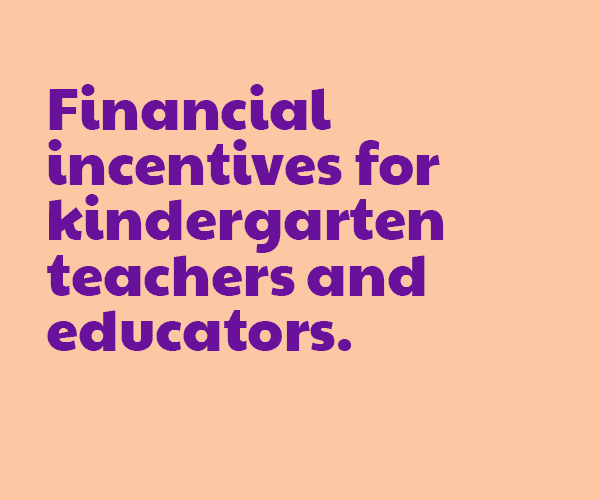Boosting motivation using the Educator Wellbeing Framework

Is your children’s service struggling with staff motivation? After a wet winter riddled with staff and children’s illnesses, on the back of some pretty horrendous years of pandemics, fires and floods, it’s no wonder your staff are struggling. Keep reading to discover how to improve motivation levels by supporting educator wellbeing.
Problems with motivation can look different for every service. For some, your team may not be inspired to implement new practices. For others, your teams or individuals may have trouble working together. For many, problems with motivation look like high turnover, lateness, work not getting done or your existing staff struggling to integrate new employees.
One of the foundations of motivation is wellbeing. You can’t be genuinely and healthily motivated in your work unless you are in a good state of wellbeing. This doesn’t mean everything has to be perfect – good wellbeing just means you have the capacity within yourself and support around you to cope with the natural ups-and-downs in life. Wellbeing encapsulates health, self, culture, relationships, resources and anything individuals need to feel comfortable to be themselves, belong and grow.
There are things service leaders have control over and some they don’t. Leaders don’t have control over people’s actions, private lives, or internal qualities like commitment or loyalty. But, leaders can set up their service to support wellbeing.
Over the past three years, CCC has been busy collating information from our members and clients about how they’ve been coping. We could see that services were all quite different in how they coped with and responded to challenges. We analysed all this information and created the Educator Wellbeing Framework.
When things are operating as usual, the little problems we have in our services are not always obvious or mightn’t be causing issues for staff. When something changes or pressure is placed on your team, these little problems become much more prominent – like how earthquakes cause sinkholes and cracks where there are weaknesses under the ground.
On the other hand, pressure or crisis can also make your services’ protective mechanisms more obvious. We heard about services who, prior to the pandemic, already had highly communicative leaders. These leaders were able to keep their staff feeling connected and motivated during lockdowns through strong communication. These leaders were in tune with how staff were coping, so when lockdown lifted and the pace and service capacity increased again, educators were well supported.
The different domains of the Educator Wellbeing Framework can help service leaders reflect on their own strengths and weaknesses. This can help you focus on how to change your service to become a supportive and motivating environment.
Sense of agency and worth
A key area when thinking about motivation is the domain of sense of agency and worth. When you are adjusting your service in any way, you need to ensure open communication with your team. It’s important that all staff are encouraged to share their experiences or seek clarity about their responsibilities. You need to build rapport with them to make sure they feel safe and welcome.
Leaders need to reflect on their attitudes and the language being used about mental ill-health or poor wellbeing. It’s important to support positive attitudes about the spectrum of mental health and normalise mental health positive language. This means not using denigrating language about mental illnesses and normalising the idea that mental health is something that fluctuates over one’s life.
Another way you can help staff to feel safe to begin to reflect on their wellbeing is to build your library of wellbeing resources. You should frequently communicate wellbeing resources and supports and try out new ones. The most important resource is an Employee Assistance Program.
When staff know their wellbeing will be taken seriously and their service supports them, they’re more likely to be honest about the source of their wellbeing or motivation problems. AccessEAP (accesseap.com.au) offers exclusive benefits for CCC members.
Education and training
Another domain to look at is education and training. When there are problems that span across the whole service, or when your service has experienced trauma or massive change, it can be vital to provide intensive educator wellbeing consultancies for the whole staff team. Intensive wellbeing consultancies help teams develop a common language and reflect on reactions as a response to physical, emotional, and spiritual needs.
There will be times when individual staff members need to have a break from work to reset and find themselves again to avoid burnout. Burnout is being emotionally exhausted, having negative attitudes toward colleagues and a negative self-perception. It needs to be taken seriously.
It’s widely known that our sector is facing a crisis in staff turnover and not enough new educators are entering our workforce. Rather than losing staff entirely, you can support individuals to heal and return by providing and helping them to access leave entitlements. If this is difficult, or you need to wait until other staff return from leave, you can assist educators to take a break by spending time in a different care environment or have more frequent access to planning or administration duties.
Call to action
The other area to think about is your ‘call to action’ in your service philosophy, mission or vision.
Your service’s call to action should meaningfully reflect the community you are part of, including educators, families, children and the wider community. When your staff are sharing the same philosophy and perspectives about why their work is important, they can begin to work towards the same goal despite their personal differences or difficulties.
If there is disagreement in your team about priorities, it might be time to renew your philosophy.
This can take time and is not always a smooth process. While your whole team needs to be a part of the philosophy renewal, it needs to be led by the service manager or a dedicated and involved member from your Committee of Management who will keep the momentum going.
Leadership style
Motivation is also impacted by the style of leadership enacted by service managers, educational leaders or the Committee of Management. A style that works well is ethically-focused leadership where leaders are embedded in the service and are providing an imagining about how the service can be the best it can be.
Collaborative leadership builds up self-agency and self-worth. Autocratic, micro-managing leaders are not providing true leadership – this style of leadership only motivates people into action because of fear, which will backfire in the long run. Leaders should model the behaviour they wish to see in their workplace and represent the best version of what the service can be. If leadership is an issue in your service, you could work with CCC consultant Narelle Lawton who has over 14 years of directing experience.
It is possible to re-ignite motivation. You must honestly reflect on where the cracks are in your context, to see where your staff are falling through. From there, you can start the journey to healing and eventually thriving.
This article first appeared in Roundtable magazine Summer 2022. The full magazine is available to CCC members through the member login on the CCC website.
Popular

Quality
Jobs News
Research
Workforce
How educators can manage emotions when it comes to working with challenging people
2024-04-10 09:40:26
by Freya Lucas

Workforce
UN elevates the importance of play by adopting an official International Day of Play
2024-04-10 10:38:29
by Freya Lucas

Workforce
Quality
Jobs News
Research
More adults are being diagnosed as neurodivergent. Here’s how employers can help in the workplace
2024-04-16 08:28:26
by Freya Lucas


















